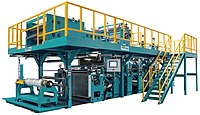Roll-to-roll processing

Have you ever seen a really long piece of tape that can be pulled out of a dispenser and cut at any length? That's a bit like what roll-to-roll processing is!
Imagine you have a very long roll of paper or plastic, and on this roll is a printed circuit, some solar panels, or even a long strip of stickers. Roll-to-roll processing is when you use a machine to feed this roll through a series of stations where different parts of the process are applied.
Picture a conveyor belt with rollers that help pull and guide the material, and at each station, something different happens. At the first station, maybe a high-tech printer lays down a thin layer of metal or ink that's needed for the circuit or stickers. Then, at the second station, maybe another machine cuts the material into smaller strips or shapes.
The material can be processed at a much quicker rate because it's all done without stopping! Instead of making one thing at a time or printing one page at a time, roll-to-roll processing can create hundreds or thousands of circuits or stickers all at once.
It's like creating a super-long chain of cookies instead of just making one batch at a time. Each cookie is a little different, but because they were all made and treated the same way, they can all be used for the same purpose.
This method of processing is used a lot in electronics and other industries where high volumes of products need to be made quickly and consistently.
Imagine you have a very long roll of paper or plastic, and on this roll is a printed circuit, some solar panels, or even a long strip of stickers. Roll-to-roll processing is when you use a machine to feed this roll through a series of stations where different parts of the process are applied.
Picture a conveyor belt with rollers that help pull and guide the material, and at each station, something different happens. At the first station, maybe a high-tech printer lays down a thin layer of metal or ink that's needed for the circuit or stickers. Then, at the second station, maybe another machine cuts the material into smaller strips or shapes.
The material can be processed at a much quicker rate because it's all done without stopping! Instead of making one thing at a time or printing one page at a time, roll-to-roll processing can create hundreds or thousands of circuits or stickers all at once.
It's like creating a super-long chain of cookies instead of just making one batch at a time. Each cookie is a little different, but because they were all made and treated the same way, they can all be used for the same purpose.
This method of processing is used a lot in electronics and other industries where high volumes of products need to be made quickly and consistently.
Related topics others have asked about:
